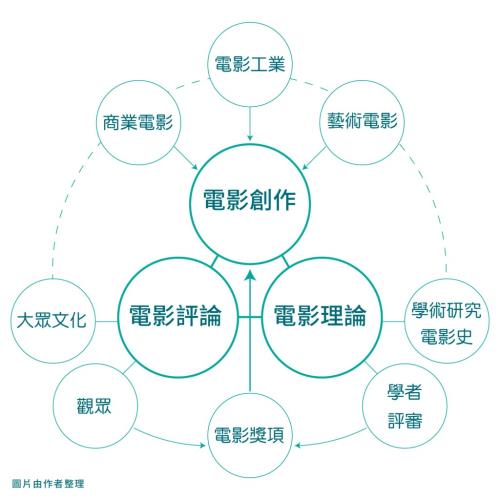Supervisor of Audio-Visual CUT Association. One of the directors of Macau Stories 1, also involved in Macau Stories 2─Love in the City and Macau Stories 3─City Maze. Macau Stories 2─Love in the City received a special mention at Portugal’s Avanca Film Festival, and was shown at film festivals in Tokyo and Osaka.

On 30th January, 2016, a talk on “Film X Critique X Audience: A Film’s Triangular Relationships” was held in The Cinematheque.Passion. Hong Kong film commentator Joyce Yang was invited to host the talk. I was lucky enough to be able to participate in it and have learnt so much from it. This also allowed me to think again what movie review is really about. And I hope that more people in Macao are able to take part in such discussion.
In general, both commercial film and art film are seen as filmmaking. And filmmaking is closely related to cinema studies and film review (as indicated in the diagram below). What most people usually see are commercial films, film reviews and film awards. Among them, film reviews are the most influential in the general public and pop culture. Film commentators usually use theories in cinema studies to interpret films. Even the influence is subtle, every commentator somehow is disciple of certain theories.
“Film review” is a very generic term. It actually can be classified into four categories:
Screening report: It’s like homework done by high school or university students. They discuss the theme and format of a film, and usually avoid having any subjective or personal comments.
Film review: The most popular form of article, such review is published in newspaper or film guide. Usually the writer assumes that the reader has not watched the film yet, and such article discloses plots and background of the film.
Theoretical essay: It’s a doctoral dissertation-like essay and can even be published as a book. The essay contains in-depth discussion about one single film, or a series of film texts and their relations to socio-culture, politics, economy, philosophy and the film industry. Usually the writer assumes that the reader has equipped with enough knowledge about film genres, history, philosophy and the film industry.
Critical essay: It’s a long essay about one single film text, and it’s something in between a film review and a theoretical article. The writer usually assumes that the reader is very familiar with the film. Plots of the film are not detailed in such essay. Instead, focus is given to certain scenes in a film, such as the lighting, how it is shot, the nuances of an actor’s expression, directing techniques and traces of the filmmaker’s works. The essay sometimes makes comparison of two or more film texts.
Most of the people are likely to see film review as an evaluation of a film. In fact, a film review has an interpreting function. Evaluation involves one’s style and preference, but interpretation is to find out the meaning of a film. Some reviews/interpretations sometimes disclose the writer’s own thoughts. They can be seen as literary work independent from film or film review.
Film reviews matter a lot to a country or a region as they have strong impact on the aesthetic values of a film and the ethos of a society. They further establish conceptions of culture and history. They proved to be useful to filmmakers too, allowing them to make references at the stage of inception, accumulate ideas and further improve their aesthetic skills. In the end, a film or its filmmaker is able to find its position in history.